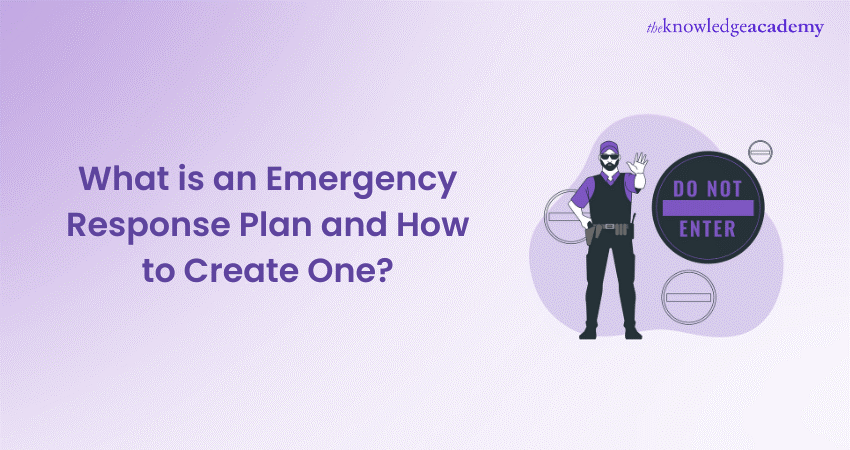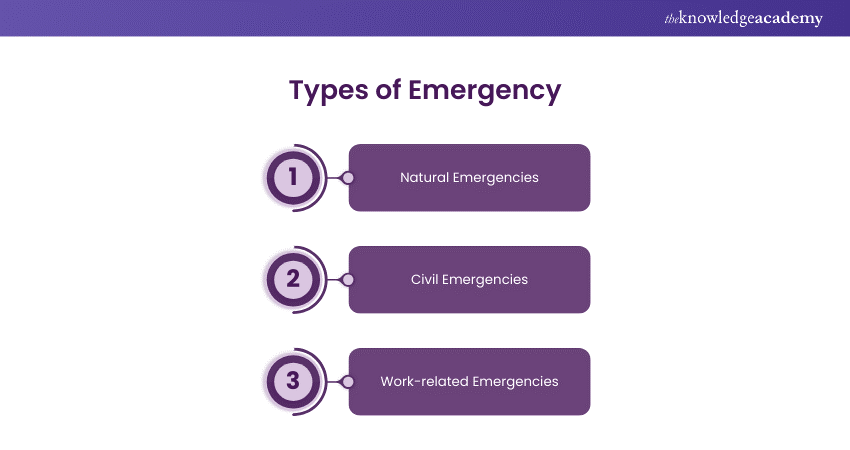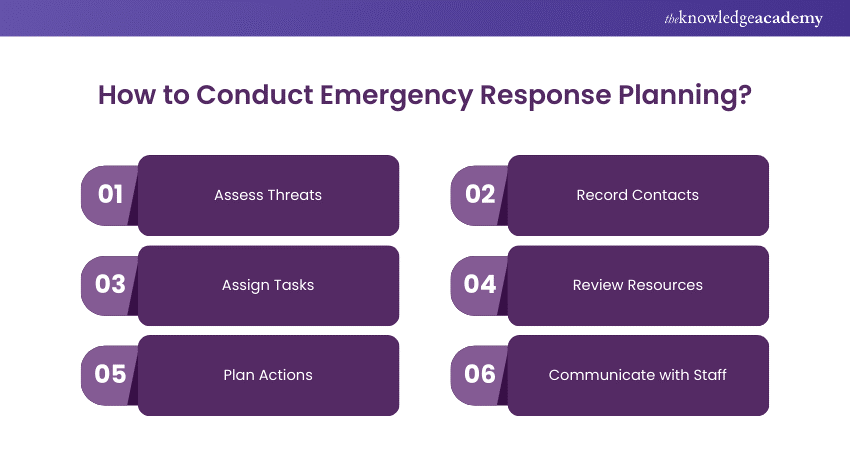We may not have the course you’re looking for. If you enquire or give us a call on +60 1800812339 and speak to our training experts, we may still be able to help with your training requirements.
Training Outcomes Within Your Budget!
We ensure quality, budget-alignment, and timely delivery by our expert instructors.

What would you do if a crisis struck right now? An Emergency Response Plan is a vital tool that prepares individuals and organisations to handle unexpected events calmly and effectively. It’s a blueprint for managing emergencies like fires, natural disasters, medical crises, or security threats.
An Effective Emergency Response Plan outlines clear roles, actions, and Effective communication steps to protect lives and property. Without one, a small issue can turn into a major disaster. Creating an ERP may seem daunting, but it’s essential for safety. Keep reading this blog to learn how to build a plan that keeps everyone safe.
Table of Contents
1) What is an Emergency Response Plan?
2) Types of Emergencies
3) How to Conduct Emergency Response Planning?
4) Emergency Response Plan Tips
5) Conclusion
What is an Emergency Response Plan?
An Emergency Response Plan is a crucial document for organisations. It outlines the steps to take during critical events like fires or active shooter situations. The main goal is to keep employees safe and minimise disruption to operations.
These plans are part of a larger emergency management strategy. They address various emergencies such as hurricanes, wildfires, winter weather, chemical spills, disease outbreaks, and other hazards. The aim is to prevent injuries and property damage during these events.
In the planning phase, organisations write down the specific steps for each emergency scenario. The plans also clarify roles and responsibilities. This specifies which staff members are on the response team and which first responders to contact.
Having an Emergency Response Plan helps organisations act quickly and effectively in dangerous situations. It reduces the risk to people and property. This proactive measure provides a clear and structured response, eliminating confusion during emergencies.
Types of Emergencies
The HSE advises that responses in an Emergency Response Plan should match the level of risk and the possible severity of the incident. Therefore, the first step in creating an Emergency Response Plan is to identify potential risks.
Crisis events vary in nature and impact on businesses and their workforces. Each event requires a specific response and has a different level of urgency. It’s important to know how to handle each situation effectively. Generally, emergencies can be divided into three categories:

1) Natural Emergencies: This type of emergencies involves natural disasters like floods, hurricanes, and fires. These can happen at any time and may cause logistical problems for the organisation.
2) Civil Emergencies: This includes strikes, protests, and workplace harassment. These can occur outside the organisation or directly involve team members.
3) Work-related Emergencies: Work-related Emergencies result from factors related to the workplace. These include chemical spills, machinery malfunctions, and gas leaks.
Drive agile transformation and lead your team to success with our specialised Agile Leadership Training – Join now!
How to Conduct Emergency Response Planning?
Creating a valid Emergency Response Plan is essential for keeping your organisation prepared for unexpected events. By following a few key steps, you can ensure that your team knows what to do in case of emergencies. Here are a few simple steps to help you plan and respond effectively.

1) Assess Threats
Start by identifying potential threats your organisation may face, such as natural disasters, fires, or security incidents. Understanding these risks helps you prepare better.
2) Record Contacts
List all emergency contacts, including first responders, medical assistance, and essential personnel. Keep this list updated so you can quickly reach the right people in an emergency.
3) Assign Tasks
Determine which staff members will handle specific tasks during an emergency. Assign roles clearly so everyone knows their responsibilities.
4) Review Resources
Check that you have necessary resources, like first aid kits, fire extinguishers, and emergency exits, and ensure you are familiar with first aid signs to respond effectively in emergencies. Ensure everything is accessible and in good condition.
5) Plan Actions
Create specific action steps for each type of emergency. Outline what to do, where to go, and who to contact for every scenario.
6) Communicate with Staff
Share the Emergency Response Plan with all employees. Make sure they understand their roles and know where to find important resources and contacts.
Transform your creativity into impactful solutions with our expert-led Design Thinking Course – Sign up now!
Emergency Response Plan Tips
An Emergency Response Plan is a lifeline for your organisation during critical events. Whether it’s a natural disaster, a civil disturbance, or a work-related incident, having a well-thought-out plan can make all the difference. Here are some critical tips to consider when developing your ERP:
1) Identify Risks: Identify the hazards that could impact your workplace. This includes everything such as natural disasters, security threats etc.
2) Form Response Team: Assemble a team with clear roles and responsibilities to manage emergency situations.
3) Set Communication Rules: Create a system for notifying employees and disseminating information during an emergency.
4) Plan Evacuations: Design evacuation procedures that are easy to follow and account for all employees, including those with special needs.
5) Provide First Aid: Ensure that first aid kits are available, and staff are trained to handle medical emergencies.
6) Protect Assets: Protect your organisation’s assets with appropriate security measures and data backup solutions.
7) Check Insurance: Make sure your insurance policies are up-to-date and provide adequate coverage for potential risks.
8) Train Staff: Regularly train employees on emergency procedures and safety protocols.
9) Update Plan: Keep your plan current by reviewing it regularly and making necessary updates.
10) Collaborate with Others: Work with local emergency services to ensure a coordinated response during emergencies.
Lead with confidence and inspire change. Sign up with our Leadership Courses and make a lasting impact.
Conclusion
An Emergency Response Plan is imperative for managing unexpected crises and protecting your organisation. By assessing risks, assigning roles, and clearly outlining actions, you ensure everyone is prepared to act quickly. A well-designed plan can minimise harm and keep operations running smoothly when emergencies arise.
Prepare for any emergency and become an effective leader with our OPITO's Incident Commander Training – Register today!
Frequently Asked Questions

The Control Phase of a response plan involves actively managing an emergency as it happens. It includes following the plan’s steps to contain risks, communicate effectively, and ensure safety. This phase aims to keep the situation under control and limit the emergency's impact on people and property.

Typically, a safety officer, emergency coordinator, or designated team is responsible for creating an Emergency Response Plan. In some cases, senior management oversees its development to ensure it meets organisational needs and complies with regulations. They involve key staff to cover all aspects of potential emergencies.

The Knowledge Academy takes global learning to new heights, offering over 30,000 online courses across 490+ locations in 220 countries. This expansive reach ensures accessibility and convenience for learners worldwide.
Alongside our diverse Online Course Catalogue, encompassing 19 major categories, we go the extra mile by providing a plethora of free educational Online Resources like News updates, Blogs, videos, webinars, and interview questions. Tailoring learning experiences further, professionals can maximise value with customisable Course Bundles of TKA.

The Knowledge Academy’s Knowledge Pass, a prepaid voucher, adds another layer of flexibility, allowing course bookings over a 12-month period. Join us on a journey where education knows no bounds.

The Knowledge Academy offers various Leadership Courses, including OPITO Incident Commander Training, Leadership Skills Training and Agile Leadership Training. These courses cater to different skill levels, providing comprehensive insights into the Behavioural Theory of Leadership.
Our Business Skills Blogs cover a range of topics related to EAP, offering valuable resources, best practices, and industry insights. Whether you are a beginner or looking to advance your Leadership skills, The Knowledge Academy's diverse courses and informative blogs have you covered.
Upcoming Business Skills Resources Batches & Dates
Date
 OPITO Incident Commander Training
OPITO Incident Commander Training
Fri 28th Mar 2025
Fri 23rd May 2025
Fri 4th Jul 2025
Fri 5th Sep 2025
Fri 24th Oct 2025







 Top Rated Course
Top Rated Course



 If you wish to make any changes to your course, please
If you wish to make any changes to your course, please


